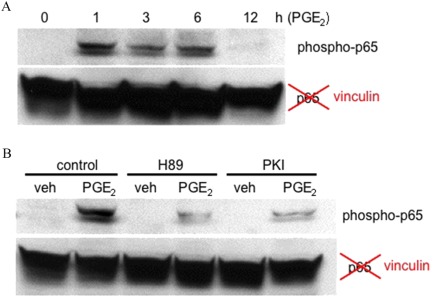The authors of Ji et al. (2012) have supplied the following corrections to their article.
In Figure 4D the immunoblots shown using antibodies against CREB are incorrect and verifiable results are unavailable for this experiment. It is noted, however, that changes in the expression of CREB were never observed as a consequence of these experimental treatments (e.g., see Figure 4C). The corrected figure is provided below.

Figures 6A and 6B were mislabeled during the preparation of the manuscript and the immunoblots identified as being probed with antibodies against p65 (NF‐κB) were actually probed with antibodies against vinculin. Additionally the time courses for the phosphorylation of I‐κBα (Figure 2B, p‐I‐κBα) and p65 (Figure 6A, phospho‐p65) were run on the same immunoblot; thus, the vinculin loading control is the same for both of these figures. The corrected figure and legend are provided below.

Time course of the PGE2 stimulated phosphorylation of the p65 subunit of NF‐κB (A) and effects of the protein kinase A inhibitors, H89 and PKI, on the PGE2 stimulated phosphorylation of p65 (B). HEK‐EP1 cells were treated with 1 μM PGE2 for indicated times at 37°C and whole cell lysates were prepared and subjected to immunoblot analysis with antibodies against either phospho‐p65 or vinculin as described in Methods. The vinculin blot shown in this panel is the same as that shown in Figure 2B, which was from the same immunoblot used to examine the time course of phosphorylation of I‐κBα.
Reference
- Ji R, Sanchez CM, Chou CL, Chen XB, Woodward DF, Regan JW (2012). Prostanoid EP1 receptors mediate up‐regulation of the orphan nuclear receptor Nurr1 by cAMP‐independent activation of protein kinase A, CREB and NF‐κB. Br J Pharmacol 166: 1033–1046. https://doi.org/10.1111/j.1476‐5381.2011.01817.x. [DOI] [PMC free article] [PubMed] [Google Scholar]


